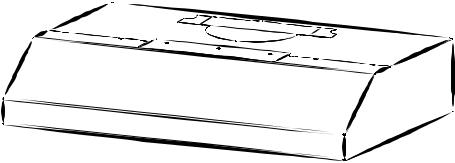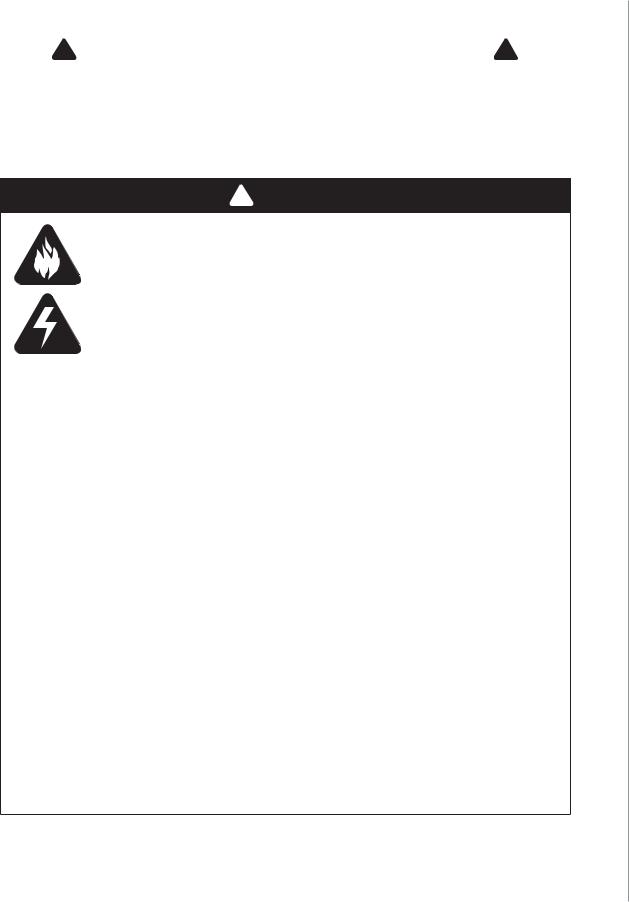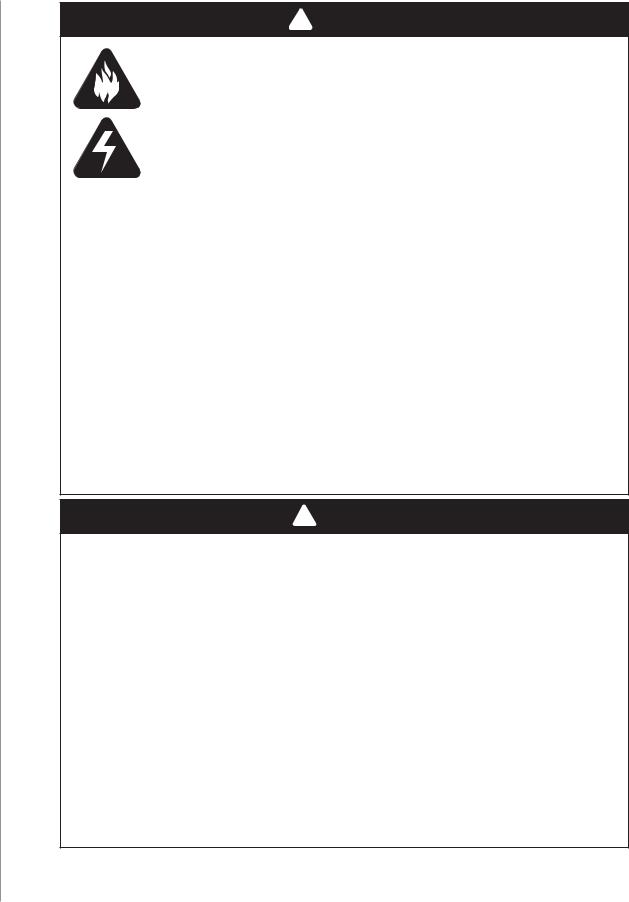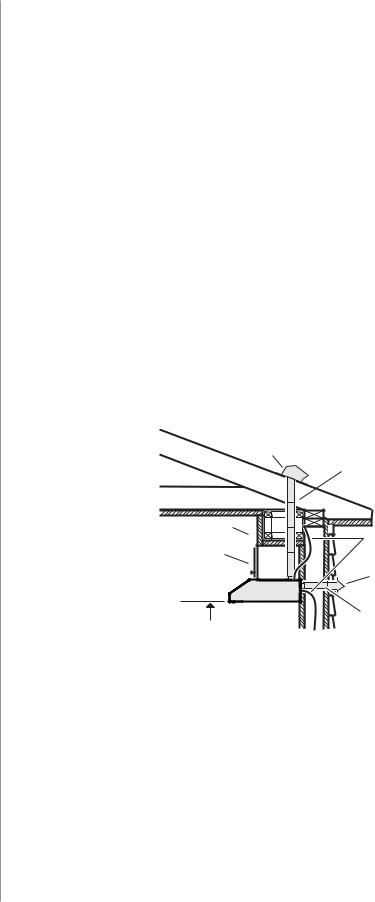Broan BCDJ136SS, BCDJ130SS Installation manual

WWW.BROAN.COM |
WWW.BROAN.CA |
WWW.NUTONE.CA |
RANGE HOOD
Series: BCDJ and NCDJ
INSTALLATION, USE
AND CARE MANUAL
Serial number: 
99045652-105B

MANUAL |
OF CONTENTS |
INSTALLATION |
TABLE |
2
Safety . . . . . . . . . . . . . . . . . . . . . . . . . . . . . . . . . 3-4
Operation . . . . . . . . . . . . . . . . . . . . . . . . . . . . . . 5-6
Cleaning and Maintenance . . . . . . . . . . . . . . . . . 7
Motors
Grease Filters
Non-Ducted Recirculation Filters
Fan Wheels
Stainless Steel Cleaning
Painted Finish Cleaning
Installation . . . . . . . . . . . . . . . . . . . . . . . . . . . . 8-20
Recommended Tools
and Accessories for Installation . . . . . . . . . . . . 8 Install Ductwork (Ducted Installations Only) . . . 8
Contents . . . . . . . . . . . . . . . . . . . . . . . . . . . . . . 9 Prepare the Hood . . . . . . . . . . . . . . . . . . . . . . . 10-12 Prepare the Hood Location . . . . . . . . . . . . . . . . 13
EZ1 One-Person Installation . . . . . . . . . . . . . 13-15 Install the Hood (EZ1 Bracket). . . . . . . . . . . . 16-17
Standard Installation . . . . . . . . . . . . . . . . . . . 18 Install the Hood (Standard Installation) . . . . . 19 Connect the Wiring . . . . . . . . . . . . . . . . . . . . . . 20
Install the Filters . . . . . . . . . . . . . . . . . . . . . . . . 20
Wiring Diagram . . . . . . . . . . . . . . . . . . . . . . . . . 21
Service Parts . . . . . . . . . . . . . . . . . . . . . . . . . 22-23
Warranty . . . . . . . . . . . . . . . . . . . . . . . . . . . . . . . 24

READ AND SAVE THESE INSTRUCTIONS
 !
!  Intended for domestic cooking only
Intended for domestic cooking only  !
! 
INSTALLER: LEAVE THIS MANUAL WITH HOMEOWNER.
In U.S.A., register your range hood online at www.broan.com
In Canada, register your Broan range hood online at www.broan.ca or register your NuTone range hood online at www.nutone.ca
 !
! WARNING
WARNING
TO REDUCE THE RISK OF FIRE, ELECTRIC SHOCK, OR INJURY TO PERSONS, OBSERVE THE FOLLOWING:
• Use this unit only in the manner intended by the manufacturer. If you have questions, contact the manufacturer at the address or telephone number listed in the warranty.
•Before servicing or cleaning unit, switch power off at service panel and lock the service disconnecting means to prevent power from being
switched on accidentally. When the service disconnecting means cannot be locked, securely fasten a prominent warning device, such as a tag, to the service panel.
•Installation work and electrical wiring must be done by a qualified person(s) in accordance with all applicable codes and standards, including fire-rated construction.
•Sufficient air is needed for proper combustion and exhausting of gases through the flue (chimney) of fuel burning equipment to prevent
backdrafting. Follow the heating equipment manufacturer’s guidelines and safety standards such as those published by the National Fire Protection Association (NFPA) and the American Society for Heating, Refrigeration and Air Conditioning Engineers (ASHRAE) and the local code authorities.
•When cutting or drilling into wall or ceiling, do not damage electrical wiring and other hidden utilities.
•Ducted fans must always be vented to the outdoors.
•Do not use this unit with any additional solid-state speed control device.
•To reduce the risk of fire, use only metal ductwork.
•This unit must be grounded.
•As an alternative, this product may be installed with the UL-approved cord kit designated for the product, following instructions packed with the cord kit.
•When applicable local regulations comprise more restrictive installation and/or certification requirements, the aforementioned requirements prevail on those of this document and the installer agrees to conform to these at his own expense.
SAFETY |
MANUAL INSTALLATION |
3

INSTALLATION MANUAL |
SAFETY |
4
 !
! WARNING
WARNING
TO REDUCE THE RISK OF A RANGE TOP GREASE FIRE:
a)Never leave surface units unattended at high settings. Boilovers cause smoking and greasy spillovers that may ignite. Heat oils slowly on low or medium settings.
b)Always turn hood ON when cooking at high heat or when flambeing food (i.e.: Crêpes Suzette, Cherries Jubilee, Peppercorn Beef Flambé).
c)Clean ventilating fan frequently. Grease should not be allowed to accumulate on fan, filters or in exhaust ducts.
d)Use proper pan size. Always use cookware appropriate for the size of the surface element.
TO REDUCE THE RISK OF INJURY TO PERSONS IN THE EVENT OF A RANGE TOP GREASE FIRE, OBSERVE THE FOLLOWING*:
1.SMOTHER FLAMES with a close-fitting lid, cookie sheet or metal tray, then turn off the burner. BE CAREFUL TO PREVENT BURNS. IF THE FLAMES DO NOT GO OUT IMMEDIATELY, EVACUATE AND CALL THE FIRE DEPARTMENT.
2.NEVER PICK UP A FLAMING PAN — You may be burned.
3.DO NOT USE WATER, including wet dishcloths or towels — This could cause a violent steam explosion.
4.Use an extinguisher ONLY if:
A.You own a Class ABC extinguisher and you know how to operate it.
B.The fire is small and contained in the area where it started.
C.The fire department has been called.
D.You can fight the fire with your back to an exit.
* Based on “Kitchen Fire Safety Tips” published by NFPA.
 !
! CAUTION
CAUTION
•For indoor use only.
•For general ventilating use only. Do not use to exhaust hazardous or explosive materials and vapors.
•To avoid motor bearing damage and noisy and/or unbalanced fan blade, keep drywall spray, construction dust, etc. off range hood.
•Your hood motor has a thermal overload which will automatically shut off the motor if it becomes overheated. The motor will restart when it cools down. If the motor continues to shut off and restart, have the hood serviced.
•For best capture of cooking fumes, the bottom of the hood MUST NOT BE LESS than 18” and at a maximum of 30” above the cooking surface.
•Always follow the cooking equipment manufacturer’s requirements regarding the ventilation needs.
•To reduce the risk of fire and to properly exhaust air, be sure to duct air outside — Do not exhaust air into spaces within walls or ceiling or into attics, crawl space or garage.
•When installing, servicing or cleaning the unit, it is recommended to wear safety glasses and gloves.
•Please read specification label on product for further information and requirements.

Operation
Always turn your hood on before you begin cooking to establish an air flow in the kitchen. Let the blower run for a few minutes to clear the air after you turn off the range. This will help keep the whole kitchen cleaner and fresher.
Operate the hood as follows:
1
NOTE: At range hood start-up or after a power failure, a small icon (1) appears shortly (for ± 2 seconds) on LCD screen; this is normal.
BLOWER ACTIVATION/SPEED LEVEL CHANGE/FILTER INDICATOR RESET
When blower is OFF, press on this push button to turn ON the blower at the last saved speed. If there was no speed saved, the blower will be set on LOW speed.
NOTE: When LOW speed is activated from OFF, the blower starts on MEDIUM speed for a very short lapse of time, and then resume to LOW speed.
To change the blower speed, press on this button again until the desired speed is reached (from LOW to MEDIUM to HIGH speed to OFF). Each time a blower speed is activated, a rotating blower icon appears on left side of LCD screen, with dot(s) under it (slow for LOW with one dot, faster for MEDIUM with 2 dots and fastest for HIGH with 3 dots).
When blower is on (no matter the speed level), press and hold this button until the blower icon disappears from the LCD screen; this will turn off the blower and save the blower speed chosen.
Heat Sentry™
This hood is equipped with a protective device that activates the blower when an abnormally high heat level is detected while the blower is activated. During the Heat Sentry activation, this device takes control of the blower and set it on MEDIUM speed while all dots under the blower icon blink. However, the lights can be still controlled. The blower will remain on MEDIUM speed until the heat is back to normal, it then returns to the speed previously selected.
NOTE: When excessive heat is detected, Heat Sentry will shut off both blower and lights while all dots under the blower icon will blink faster. Both blower and lights will remain off until the ambient temperature cools down; the blower will then start on MEDIUM speed (the lights can be controlled again). The blower will remain on MEDIUM speed until the heat is back to normal, it then returns to the speed previously selected.
FILTER CLEANING REMINDER
This icon appears on LCD screen 30 seconds after turning OFF the blower when it is time to clean hood and filters (refer to Cleaning and Maintenance on page 7). This happens every time the blower is turned OFF until the filter cleaning reminder has been reset. Once the cleaning is done, reset the filter cleaning reminder by pressing on blower activation push button for 3 seconds while the icon appears on LCD screen for 30 seconds.
OPERATION |
MANUAL INSTALLATION |
5

DELAY OFF
When the blower is on, press this button to activate the delay function. This icon appears on LCD screen beside the blower icon to indicate the function is on. The blower will continue to operate for 10 minutes and then, will shut off automatically (both blower and delay icons will disappear from LCD screen). When Delay off is activated, it is possible to change the blower speed by pressing on blower push button without affecting the remaining time of the delay.
To cancel the delay off function before the end of the 10-minute cycle, press button again.
ON LIGHTING/LIGHT INTENSITY CHANGE
Press this button to turn on the lights at the last saved intensity; the light icon appears on right side of LCD screen and the number of dots below it shows which light intensity is on (one dot for LOW, two dots for MEDIUM and three dots for HIGH).
To change the light intensity, press the button until the desired level is reached (from HIGH intensity, pressing again will shut off the lights.
When lights are on (no matter the light intensity), press and hold this button until the light icon disappears from the LCD screen; this will shut off the lights and save the chosen light intensity. The LED modules included with this hood are the latest in LED cooktop illumination technology specially designed to operate in the elevated temperatures of cooking - offering bright lighting and lasting up to 25 times as long as a standard bulb and greater reliability than typical replacement LED bulbs.
MASTER ON/OFF
Press this button to turn on the lights and the blower at the last saved intensity. When either lights or blower are ON, pressing this button will memorize the current blower speed and lighting level prior to shut them OFF.
INSTALLATION MANUAL |
OPERATION |
6

Cleaning and Maintenance
Proper maintenance of the Range Hood will assure proper performance of the unit.
MOTORS
The motors are permanently lubricated and never need oiling. If the motor bearings make excessive or unusual noise, replace the motor with the exact service motor. The fan wheel should also be replaced.
GREASE FILTERS
The grease filters should be cleaned frequently. Use a warm dishwashing detergent solution. Grease filters are dishwasher safe.
Clean all-metal filters in the dishwasher using a non-phosphate detergent. Discoloration of the filters may occur if using phosphate detergents, or as a result of local water conditions - but this will not affect filter performance. This discoloration is not covered by the warranty. To minimize or prevent discoloration, hand wash filters using a mild detergent.
NON-DUCTED RECIRCULATION FILTERS
The non-ducted recirculation filters should be changed every 3 to 6 months. Replace more often if your cooking style generates extra grease, such as frying and wok cooking. Refer to installation instructions included with non-ducted recirculation filters.
FAN WHEELS
The center of the fan wheels should be cleaned frequently. Use a clean cloth soaked with warm detergent solution.
STAINLESS STEEL CLEANING
Do:
•Regularly wash with clean cloth or rag soaked with warm water and mild soap or liquid dish detergent.
•Always clean in the direction of original polish lines.
• Always rinse well with clear water (2 or 3 times) after cleaning. Wipe dry completely.
•You may also use a specialized household stainless steel cleaner.
Don’t:
•Use any steel or stainless steel wool or any other scrapers to remove stubborn dirt.
•Use any harsh or abrasive cleansers.
•Allow dirt to accumulate.
•Let plaster dust or any other construction residues reach the hood. During construction/ renovation, cover the range hood to make sure no dust sticks to the stainless steel surface.
Avoid when choosing a detergent:
•Any cleaners that contain bleach will attack stainless steel.
•Any products containing: chloride, fluoride, iodide, bromide will deteriorate surfaces rapidly.
•Any combustible products used for cleaning such as acetone, alcohol, ether, benzol, etc., are highly explosive and should never be used close to a range.
PAINTED FINISH CLEANING:
Clean with warm water and mild detergent only. If discoloration occurs, use a finish polish such as automotive polish. (DO NOT use rough abrasive cleaner or porcelain cleaner.)
MAINTENANCE AND CLEANING |
MANUAL INSTALLATION |
7

INSTALLATION MANUAL |
INSTALLATION |
8
For ADA compliance installation guidelines, please visit www.broan-nutone.com
Recommended Tools and Accessories for Installation
•Measuring tape
•Phillips screwdriver no. 2
•Nutdriver or socket 11/32”
•Flat blade screwdriver (to open knockout holes)
•Drill, 1/8” drill bit and 1½” hole saw (to mark holes for ducting and cut electrical access hole)
•7/64” drill bit (to drill holes for EZ1 brackets mounting screws)
•Wood shims (2) and wood screws (4) (required for standard installation to framed cabinet)
•Saw (to cut holes for ducted application)
•Sheet metal shears (ducted installation only, for duct adjustment)
•Pliers (ducted installation only, for duct adjustment)
•Metal foil duct tape (for ducted applications)
•Scissors (to cut metal foil duct tape)
•Pencil
•Wire stripper
•Strain relief, 1/2” diameter (to secure house wiring cable to the hood)
Install Ductwork (Ducted Installations Only)
|
ROOF CAP |
3¼" X 10" OR |
|
|
|
|
|
7" ROUND DUCT |
|
|
(FOR VERTICAL |
|
|
DISCHARGE) |
SOFFIT |
|
HOUSE WIRING |
|
|
|
CABINET |
|
(TOP OR BACK OF HOOD) |
|
|
WALL CAP |
|
HOOD |
|
|
3¼" X 10" DUCT |
18" MIN - 30" MAX |
(FOR HORIZONTAL DISCHARGE) |
ABOVE COOKING SURFACE
NOTE: Distances over 30” are at the installer and user discretion.
1 ] Determine whether hood will discharge vertically (3¼” x 10” or 7” round), or horizontally (3¼” x 10” only).
2 ] Decide where the ductwork will run between the hood and the outdoors.
3 ] Choose a straight, short duct run to allow the hood to perform most efficiently. Long duct runs, elbows and transitions will reduce the performance of the hood. Use as few of them as possible. When possible, use at least 2 foot straight runs before any turns. Larger ductwork may be required for best performance with longer duct runs.
4 ] Install wall cap or roof cap (sold separately); ensure there is no leak in house insulation. Connect metal ductwork to cap and work back towards the hood location. Use 2” metal foil duct tape to seal the joints between ductwork sections.
